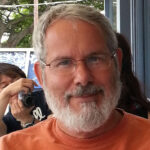I am a life-long space exploration and astronomy enthusiast who is also an avid astrophotographer. This site is primarily about my astronomy-related hobbies, which are solar system photography using lucky imaging techniques, and deep space object photoraphy using deep exposure techniques. Living beneath the Baltimore-Washington light pollution dome creates the need to travel to remote, dark sky sites for deep space imaging. How I travel to, sustain myself, and conduct imaging at dark sky sites is also a hobby, it is a third focus of this web site.
Planetary (Lucky) Imaging Techniques. Lucky imaging uses very long telecopic focal lengths (i.e., very high magnification) to capture fine detail in solar system objects such as the sun, moon, and planets that are millsions of mile away. Both the target and the undesireable effects of the turbulent atmosphere, or atmospheric seeing, are magnified. Lucky imaging techniques used for solar system photography seek to overcome bad seeing by collecting massive numbers of image frames in high-speed video captures. As luck will have it, some frames will have been captured during exceedingly brief periods of “perfect” seeing. Image processing techniques seek to pull the highest quality frames out of the capture for rendering a final image.
Deep Space Object (DSO) Imaging Techniques. For faint objects more distant than those objects in the solar system, deep space imaging techniques are used. DSOs accessible to amateur astronomers are tens to thousands of light years away. The targets in this category are various types of nebulae, galaxies, and star clusters. The techniques used for DSO imagery seek to reveal very faint and fine detail by stacking mulitiple images to accumualate more signal (photons from the object) and overcome noise.This entails collection of seconds to minutes-long exposures that are stacked into a final image.
Astronomy Camping. Perhaps as a cruel joke on astronomers, temperate summer nights are exceedingly short while long winter nights are exceedingly cold. On top of this, the dark skies needed for DSO imaging are in remote locations where few of us live, and where adequate lodging facilities are seldom available. Camping at regional star parties or other dark sites, therefore, become part of the astrophotography hobby. As about half of my astronomy camping is in the winter months, and I am adverse to discomfort, I spend a lot of time thinking about and preparing for astronomy camping expeditions.
Other Astronomy Stuff. I use guides as a means to document the procedures that I use for various aspects of my hobby. These guides ensure that I do not start from scratch for something that I have not done for a while, and they are a convenient way to share proceedural information that might be of help to others. I enjoy writing astronomy articles and posts that cover what I am doing, and what I have done.
Guides
Articles
Posts
© James R. Johnson, 2022.jim@jrjohnson.et

